Традиционная немецкая кухня далека от диетической. Кулинарные традиции страны начали формироваться в период Древнего Рима, однако, активное развитие немецкой кухни приходится на послевоенные годы, когда на традиции в кулинарии оказывали влияние культуры соседних стран.
О способности одного человека влиять на кулинарные традиции
Как наглядно демонстрирует история, монархи способны влиять не только на политику и культуру страны, но также на кулинарные предпочтения и традиции своего народа. Таким историческим примером является Германия. Король Кайзер Вильгельм II отличался суровым нравом и строгостью. В годы своего правления он ввел строгий запрет на разговоры во время еды, а также обсуждение блюд и продуктов в обществе. Разговоры на данную тему считались постыдными. Кроме этого, король отрицательно относился к кулинарным изыскам, поэтому людям — простым и аристократам — приходилось питаться очень просто и пресно. Единственная «краска», которую было разрешено подавать к столу, — мучной соус.
Интересный факт! Крайне редко и с опаской баловали себя деликатесами жители регионов, соседствующих с Россией и Данией.
По окончании Первой Мировой войны король отрекся от престола и жители Германии, не занимавшиеся развитием национальной кухни, стали голодать. Только с 1948 года на местном телевидении появились кулинарные шоу, а в книжных магазинах — сборники рецептов. Кроме этого, немцы начали активно путешествовать и привозить различные рецепты блюд. Таким образом, немецкая кухня прошла сложный, тернистый путь прежде чем стать такой, какой ее знают сегодня в мире — калорийная, сытная, видимо, таким образом немцы стараются забыть о пресных и голодных годах в истории страны.
Национальная немецкая кухня — традиции и предпочтения
Несмотря на то, что кулинарные традиции в Германии начали формироваться относительно недавно, в стране уже сложилась определенная культура питания, а многие национальные блюда немецкой кухни известны и любимыми во многих государствах.
Полезно знать! В Германии постоянно совершенствуют национальные рецепты, с каждым годом возрастает интерес к виноделию, поскольку местные жители любят угощаться бокалом местного вина.
Пожалуй, любимые и самые распространенные блюда в Германии — из свинины, из мяса готовят колбаски, сосиски, паштеты. Одних только колбас в национальном меню около полутора тысяч и это не удивительно, ведь каждый регион страны придумывает авторский рецепт.
Важное дополнение к мясным деликатесам — хлеб и выпечка. В Германии насчитывается не менее трех сотен сортов хлеба, а сколько печеных десертов — посчитать практически невозможно.
Интересный факт! В городе Ульма построен Хлебный музей, где детально описаны все сорта хлеба в Германии.
Наиболее распространенный и известный гарнир к мясу — кислая капуста, немцы также любят и умеют готовить картофель, его жарят, варят, тушат, запекают, жарят оладьи.
Что едят в Германии на завтрак? Прежде всего, этот прием пищи плотный и сытный, как правило, кушают хлеб с несколькими сортами ветчины, хлебцы с повидлом, медом, йогурт и булочки. В обед немцы обязательно кушают суп, на второе — мясо с гарниром, завершают трапезу десертом, на ужин — салат и холодные закуски. Кушать в Германии принято не менее пяти раз в день.
Интересные факты о традиционной немецкой кухне
- Туристам наверняка бросится в глаза тот факт, что в каждом немецком городе огромное количество точек, где продают сосиски и колбасу, стоят они недорого и привлекают внимание ароматом. Подают мясные деликатесы с картофельным салатом или в виде хот-дога.
- В быту жители Германии редко готовят немецкие национальные блюда, которые отличаются калорийностью и жирностью. Зато подобные угощения с удовольствием заказывают туристы, поэтому заведений, где в меню представлена традиционная для Германии кухня, много.
- В выходные дни после обеда немцы балуют себя вкусным дополнением, например, подают кофе с пирожными, а десерт меняют в зависимости от сезона года.
- В Германии не принято приглашать «на обед», приглашают «на кофе».
- Главный прием пищи — завтрак. У немцев не принято выходить из дома, предварительно плотно не поев.
- Все кафе Германии предлагают широкий выбор блюд к завтраку и подают их с утра и вплоть до 15-00.
- Особенности немецкой кухни разнятся в зависимости от региона. Например, в северных областях предпочитают картофель, едят его много, а на юге — пью чай вместо кофе, в Альпах традиционно пьют молоко и употребляют много сыра.

Что попробовать в Германии из еды
Не случайно Германия у многих туристов ассоциируется с сосисками и пивом, действительно, эти два продукта здесь умеют готовить и сочетать мастерски. Тем не менее, оценивать национальные блюда немецкой кухни только по мясным деликатесам и пенному напитку было бы неправильно, ведь в каждом регионе есть свои персональные угощения, используются своеобразные кулинарные технологии. На юго-западе придерживаются французских традиций. Визитная карточка Баварии — колбаски, тушеная капуста, сладкая горчица. В Рейнской области предпочитают блины из картофеля с маринованной говядиной, а в Гамбурге прекрасно управляются с морепродуктами. Оказавшись в Кельне, обязательно попробуйте миндальное печенье.
Немцы предпочитают есть сытно и вкусно, доказательство этому — разнообразное национальное меню с большим выбором как простых, так и сложных кулинарных шедевров.
Основные блюда
Белые колбаски Вайсвурст
Название колбасок означает — отварная телячья колбаса. По рецепту в равных пропорциях смешивают свиной и говяжий фарш, пряности, лук, белок, пикантную свежесть придает лимонная цедра.
Интересно, что блюдо традиционной кухни появилось в 1857 году, рецептура колбасок остается неизменной. Местные жители едят вайсвурст только до 12-00, после полудня колбаски не заказывают.
Мясной деликатес подают в горшочке, где тушились колбаски, с гарниром из соленого кренделя, горчицы.
Рулетики из говядины
Традиционное немецкое блюдо подают по воскресеньям во многих семьях. Особенно в холодную погоду рулетики становятся особенно популярными. Мясо фаршируют измельченными солеными огурцами, беконом, обжаренным луком с горчицей.
Говяжьи рулетики подают вместе с соусом, сваренным из мясного бульона, красного вина, овощей. Лучший гарнир — клецки с тушеной капустой или картофель.
Маульташен (Maultaschen)
Название традиционного немецкого блюда означает — пельмени, рецепт следующий — замешивают тесто, готовят начинку из фарша, шпика, свинины и пряностей. Затем начинка заворачивается в небольшие конвертики, которые отвариваются в мясном бульоне.
Интересный факт! Блюдо придумали монахи из монастыря Маульбонн, когда мясо употреблять нельзя, они готовят конвертики с постной начинкой из зелени.
Рулька по-берлински
Это угощение традиционной кухни распространено на востоке Германии. Для приготовления потребуется свиная голень, которую проваривают в пиве, затем запекают. Для особенного аромата и богатого вкуса добавляют можжевеловые ягоды, чеснок, букет специй. В местных ресторанах рульку подают с пюре из гороха, квашеной капустой.
Интересный факт! Рулька имеет глянцевую, блестящую корочку, поэтому название немецкого блюда «Eisbein» переводится, как ледяная нога.
Лаубскаус
Суп из селедки, мяса, картофеля, свеклы, соленых огурцов, лука. Местные рыбаки называют национальное первое блюдо — рыбной солянкой. Внешне суп выглядит не слишком привлекательно, но на вкус достаточно оригинальный. Впервые варить суп начали балтийские моряки, соединив все продукты, находившиеся под рукой.
Кенигсбергские клопсы
Отварные фрикадельки подают в Германии с 19 века. По рецепту клопсы готовят из телячьего фарша, яиц, хлеба, анчоусов, лимонного сока, горчицы и белого вина.
Полезно знать! В магазинах угощение продают в виде полуфабрикатов, но настоящее блюдо, приготовленное по традиционному рецепту, можно попробовать в ресторане или кафе.
Фальшивый заяц
Несмотря на загадочное и оригинальное название, традиционное блюдо представляет собой мясную запеканку с луком, картофелем. Внутрь добавляются целиком отварные яйца.
Блюдо появилось в национальном меню по окончании Второй Мировой войны. После боевых действий в стране был дефицит продуктов, в лесах почти не осталось зверей, поэтому женщины придумали угощение, которое внешне напоминало заячью спинку.
Шницель
Название национального блюда, несомненно, хорошо знакомо всем, но знаете ли вы технологию приготовления шницеля? В каждом регионе Германии угощение жарят по авторскому рецепту. В Гамбурге — это котлета с яичницей, также есть шницель по-хольстенски — мясо с яичницей, каперсами и анчоусами. Самое простое блюдо по-венски — простая свиная котлета.
Полезно знать! Все шницели объединяет одно — перед обжариванием мясо обваливают в сухарях, а после приготовления, перед подачей на стол, поливают лимонным соком.
Выбирайте жилье и узнавайте Цены с помощью этой формы
Booking.com
Гарниры
Кислая капуста зауэркраут
Знаменитая квашеная капуста, которая считается исконно немецким блюдом. В Германии его называют Krauts. Нашинкованную капусту заквашивают с помощью уксуса и соли. В целом традиционный рецепт похож на наш, родной, но с одним отличием — в состав не добавляют морковь и яблоки. Готовую кислую капусту тушат или жарят и подают в качестве гарнира к мясу.
По традиции немецкие хозяйки квасят капусту на протяжении шести недель, баночку закуски можно приобрести в любом магазине в Германии.
Интересный факт! Немцы с удовольствием едят квашеную капусту в качестве закуски к пиву.
Картофель
Примечательно, но картофель в Германии изначально восприняли без энтузиазма, более того, местные жители отказывались его выращивать и употреблять в пищу. Почему так сложилось, исторические документы умалчивают, возможно, люди не верили, что картофелем можно насытиться. Ситуация изменилась спустя два века и причиной этому стал неурожай овощей и фруктов, заставивший местное население обратить внимание на клубни. С тех пор немцы прекрасно освоили не только разведение картофеля, но и огромное количество рецептов из него.
Интересный факт! Немецкие лингвисты даже название «картофель» связывают с двумя немецкими словами — крафт — сила и тройфель — дьявол.
Самые распространенные картофельные блюда:
- кнедли — отварные шарики из картошки, подают с мясом и соусом;
- картофельный салат — назвать единый рецепт этого традиционного блюда невозможно, поскольку в каждом регионе его готовят по-своему;
- картофельная пицца, популярная в швабской кухне;
- в Мекленбурге любят картофельный суп с запеченной сливой и ветчиной;
- картофельная колбаса готовится из картошки, фарша и свиной кишки с добавлением целого букета пряностей;
- картофельные оладьи — рецептов этого угощение по всей Германии огромное количество, их готовят с мукой и без муки, с изюмом, молоком, дрожжами или без них;
- картофельное пюре с добавлением яблочного пюре, к слову, в Мекленбурге вместо яблочного используют грушевое пюре.
Десерты
Шварцвальдский торт или Черный лес
Рецепт этого знаменитого национального десерта появился в 1915 году. Баварский кондитер использовал шоколадные пирожные и украсил их сливочным кремом и вишней. С тех пор угощение стало популярным на всей территории Германии, а спустя полтора десятка лет рецепт распространился по всему миру. Сегодня рецептура торта выглядит следующим образом — бисквитные коржи пропитывают ликером (вишневым сиропом), смазывают взбитыми сливками, выкладывают вишню (вишневое желе), а сверху украшают тертым горьким шоколадом.
Интересно, что название традиционный десерт получил из-за своей расцветки — сочетание черного, коричневого и белого — это цвета национальной одежды жителей горного Шварцвальда.
Кекс Штоллен
В составе кекса большое количество пряностей, специй. Изюма, орехов, цукатов. Сверху угощение щедро посыпают сахарной пудрой, чтобы кекс напоминал новорожденного Иисуса Христа, завернутого в белую пеленку.
Впервые блюдо приготовили в 1329 году, рецептура вызвала много нареканий, поскольку незамысловатый вкус теста из овса, воды и муки не впечатлил требовательных немцев. Тогда было принято решение добавить в тесто сливочное масло.
Интересный факт! По одной из легенд, автор десерта — придворный пекарь Генрих Драздо из города Торгау.
Сегодня в Германии готовят кексы с разнообразными начинками, но самым популярным и традиционным является Дрезденский штоллен — это название запатентовано для рождественского кекса. Раньше штоллен назывался штрицель, по этой причине рождественский рынок в Дрездене называется Штрицельмаркт — рынок, где продают штрицели. Главная особенность угощения — оптимальный вкус кекс приобретает через две недели после выпечки.
Брецель или бретцель
Традиционный немецкий крендель, распространенный в южных регионах Германии. Угощение готовят с 13 века и всегда к выпечке подходят с особым вниманием и аккуратностью. В данном случае рецептура и форма кренделя строго регламентированы. Форма брецеля напоминает руки, сложенные на груди во время молитвы. Крендель принято посыпать крупными кристаллами соли. Рецептов выпечки много — с колбасой, семенами кунжута и тыквы, тертым сыром.
Интересный факт! Непосредственно перед выпечкой крендель опускают в раствор натриевой щелочи, который на немецком языке звучит как лауген, именно поэтому крендель также называют лаугенбрецель.
Что попробовать в Германии из уличной еды
Немцы не брезгуют быстрыми, легкими перекусами, уличная еда представлена в небольших фургончиках, которые есть в каждом немецком городе.
Что едят в Германии из уличной еды:
- братвурст — колбаска в булочке, для приготовления используется секретный ингредиент;
- карривуст — нарезанные колбаски, приправленные соусом карри, подают вместе с картофелем-фри;
- леберкезе — острое мясо в пшеничной булочке;
- сельдь в булочке — пшеничный хлеб с маринованной сельдью, солеными огурцами, луком и листьями салата.
Напитки
Конечно, Германия, прежде всего, ассоциируется с пивом отменного качества. Уже на протяжении многих столетий местные пивовары придерживаются рецептуры, которая была узаконена в 1871 году. В соответствии с законом в состав традиционного пива могут входит только: хмель, солод, вода и дрожжи.
Интересный факт! В Германии работает более 1200 заводов по изготовлению пиво, это не считая частных пивоварен.
Пиво принято подавать с густой пеной — это признак качества. Кроме пенного напитка в Германии активно развивается виноделие, также готовят вкусный шнапс, глинтвейн и сидр. Среди всего разнообразия алкогольных напитков немцы предпочитают чай и кофе.
Полезно знать! Обязательно попробуйте бионад — газированный напиток, который готовится по технологии пивоварения, и представляет собой лимонад с разными вкусами.
Итак, в Германии любят сытно и вкусно поесть, поэтому порции в ресторанах и кафе большие. На первый взгляд национальная немецкая кухня может показаться слегка сумасшедшими, но просто попробуйте их и поймете, что кулинарные предпочтения немцем во многом сходи с нашими.
Видео: уличная еда в Германии.
Автор: Юлия Матюхина
From Wikipedia, the free encyclopedia
Below is a list of dishes found in German cuisine.
Famous dishes[edit]
| Name | Image | Region | Description |
|---|---|---|---|
| Aachener Printen | 
|
Aachen | A type of gingerbread that is typical for the city of Aachen. |
| Apfelkuchen | 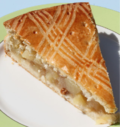
|
Throughout Germany | German pastry consisting of sliced apples |
| Bratkartoffeln | 
|
Throughout Germany | Fried potato slices, often with diced bacon or onions |
| Bratwurst | 
|
Throughout Germany | Sausage that is usually composed of veal, pork or beef. It is a traditional German sausage. Not to be confused with curry wurst. |
| Currywurst | 
|
Berlin, Rhine-Ruhr | This large-format, fried or grilled wiener is cut into thick slices and seasoned with spicy ketchup and generous amounts of curry powder, usually served with french fries — a popular snack originating in early 1950s Berlin. Both Bockwurst-style (i.e. intended to be boiled) and Bratwurst-style (i.e. intended to be grilled or fried) sausages are used, depending on region, and the use of one or the other is a matter for much debate among Currywurst gourmets. Currywurst remains one of the most popular fast foods in Germany, especially in Berlin and the Rhine-Ruhr area, but the Döner kebab is gaining rapidly in popularity. |
| Fischbrötchen | 
|
Northern Germany | Sandwich made with various fish (pickled or fried) and onions, common in Northern Germany, particularly along the coast |
| Hendl | 
|
Austro-Bavarian | Whole grilled chicken marinated with pepper and other spices this dish is known as Brathühnchen, Brathähnchen, and in eastern Germany, also as Broiler. |
| Hasenpfeffer | A stew made from marinated rabbit | ||
| Kartoffelsalat | 
|
Northern Germany and South Germany | Potato salad, which comes in many varieties, for example in a cream or mayonnaise dressing (northern Germany) or even in meat broth (south Germany), is often served as a side dish to Bratwurst or boiled sausages). |
| Knödel (also known as Kloß, depending on region) | 
|
Throughout Germany | German dumplings; many different variations:
|
| Königsberger Klopse | 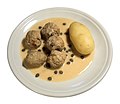
|
East-Prussian: city of Königsberg | Cooked meatballs served in a white sauce with capers |
| Kohlroulade | 
|
Throughout Germany | German-style cabbage rolls |
| Marzipan | 
|
Throughout Germany | E.g. Lübeck-style, widely used in Christmas specialities |
| Pellkartoffel [de] | 
|
Throughout Germany | Boiled or steamed potatoes before peeling (young potatoes may be eaten unpeeled), served with Quark and linseed oil, butter, or as a side dish with herring). |
| Pfefferpotthast | Westphalia | A traditional peppered beef stew of the German cuisine that belongs to the cuisine of Westphalia. | |
| Rinderroulade | 
|
Throughout Germany | A roulade of bacon and onions wrapped in thinly sliced beef |
| Sauerbraten | 
|
Rhineland | A beef pot roast marinated in vinegar, water, spices and seasonings |
| Sauerkraut | 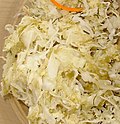
|
Throughout Germany | Fermented shredded cabbage |
| Schnitzel | Throughout Germany | Fried, breaded thin piece of meat, typically pork or beef | |
| Schweinshaxe | 
|
Pork hock served grilled and crispy with Sauerkraut or boiled as Eisbein | |
| Spanferkel | 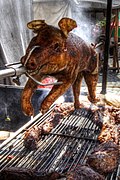
|
Throughout Germany | A grilled whole young pig, usually eaten in a large company of friends or guests |
| Speckpfannkuchen | Large, thin pancakes with diced, fried bacon | ||
| Spätzle | 
|
Southern Germany | These hand-made noodles are very popular and are an important ingredient of several dishes, such as Linsen mit Spätzle or Käsespätzle. |
| Stollen | 
|
Dresden | A bread-like cake with dried citrus peel, dried fruit, nuts, and spices such as cardamom and cinnamon; it is usually eaten during the Christmas season as Weihnachtsstollen or Christstollen. The best-known Stollen is from Dresden and is sold at the Striezelmarkt Christmas market, which derives its name from the cake. |
| Weihnachtsgans | 
|
Throughout Germany | A roasted goose is a popular dish on Christmas Day.[1] |
Baden-Württemberg[edit]
| Name | Image | Type | Description |
|---|---|---|---|
| Maultaschen | 
|
Main course | Noodle filled with various ingredients, such as meat, spinach, onions, spices: Maultaschen are either served with broth or cut into slices and fried with eggs. |
| Brenntar | 
|
Main course | It is made of roasted flour called Musmehl, usually spelt flour or oat flour. It is usually cooked like a porridge with water and milk with various ingredients. |
| Sauerbraten | 
|
Main course | A vinegar-marinated roast traditionally made of horse meat, although nowadays the majority is made of beef. |
| Filderkraut [de] | 
|
Side dish | A finely cut pointed white cabbage that has been fermented by various lactic acid bacteria. |
| Spätzle | 
|
Pasta | A kind of soft egg noodle found in the cuisines of southern Germany and Austria, Switzerland, Hungary, Moselle and South Tyrol. |
| Linsen mit Spätzle | 
|
Main course | Hearty dish that combines Spätzle with cooked lentils and Vienna sausages. |
| Schupfnudel | 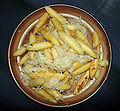
|
Pasta | Pasta made from potatoes and flour, often served with Sauerkraut. |
| Flädlesuppe | 
|
Entree | A broth with thin strips of German-style pancakes. |
| Springerle | 
|
Snack | Cookies made by pressing dough into intricate molds. Commonly used for dunking into a drink, as they are quite hard. |
| Zwiebelkuchen | 
|
Main course | An onion cake, a seasonal dish served around October, usually eaten while still warm and accompanied by slightly fermented red or white grape juice called Süser or (more commonly in other regions) Federweißer. |
| Flammkuchen | 
|
Main course | A pizza-like dish with thin crust and onion, bacon and crème fraîche topping. |
| Gaisburger Marsch | 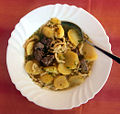
|
Main course | A famous stew made of meat, potatoes, Spätzle and several kinds of vegetables like potatoes and carrots. |
| Käsespätzle | 
|
Main course | Dish of Spätzle and fried onions gratinated with cheese. |
| Wibele | 
|
Snack | Small, sweet biscuits. |
| Himbeergeist | 
|
Beverage | A fruit-based Schnapps produced mainly in Germany and the Alsace region of France. |
| Kirschwasser | 
|
Beverage | A clear, colorless fruit brandy traditionally made from double distillation of morello cherries, a dark-colored cultivar of the sour cherry. |
Bavaria[edit]
| Name | Image | Type | Description |
|---|---|---|---|
| Bierwurst | 
|
Coldcuts | A German cooked, smoked Brühwurst sausage originally from Bavaria, with a garlicky flavor and dark red color. It is seasoned with black peppercorns, paprika, and mustard seeds for flavor. |
| Blutwurst | 
|
Coldcuts | A type of blood sausage originating in Bavaria. |
| Brotzeit | 
|
Main course | A traditional German savory snack native to the Bavarian cuisine and it literally means «Bread time». |
| Weißwurst | 
|
Snack | Lt.:’White sausages’; a speciality from Munich, traditionally eaten for second breakfast. Always accompanied by sweet mustard, pretzels, and wheat beer. Traditionally not served after 12 noon because in earlier days, before fridges, the sausages had to be consumed before 12 noon so that they didn’t decay. But, nowadays, people also eat it for dinner or lunch. |
| Weizenbier | 
|
Beverage | A beer, usually top-fermented, which is brewed with a large proportion of wheat relative to the amount of malted barley. The two main varieties are Weissbier and Witbier; the minor types include Lambic, Berliner Weisse and Gose. |
| Helles | 
|
Beverage | A German beer style that is usually drunk in Bavaria, Germany. It has a yellow, gold color, and has 4.5-6% alcohol. |
| Radler | 
|
Beverage | A beer mixed with citrus lemonade |
| Kartoffelkäse | 
|
Side dish | A spread from the regions of Bavaria and Austria that literally means «Potato cheese». |
| Münchener Bier | 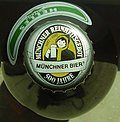
|
Beer | A protected geographical indication for beer since 1998, which is brewed within the city limits of Munich by the breweries Augustiner Bräu, Spaten-Franziskaner-Bräu, Hacker-Pschorr, Paulaner, Hofbräu and Löwenbräu, which are members of the Münchner Brauereien. |
| Schweinsbraten [de] | 
|
Main course | Sliced pork roast with a crunchy crust that was boiled in a pot. |
| Schweinshaxe | 
|
Main course | Braised pork leg with a crunchy brown crust on the outside, and a moist and juicy inside. Served with gravy and Klöße. |
| Leberkäse | 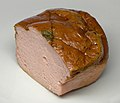
|
Snack | A type of sausage baked in a mould and cut into slices. When eaten as a main course, it is sliced and served with an egg (must be sunny side up style), and mashed potatoes. For a quick lunch, it is usually eaten in a bread-roll with mustard, a bit like a hotdog. Some people eat the Leberkäse with hot mustard, others with sweet mustard. |
| Leberknödel | 
|
Soup | A traditional dish of German, Austrian and Czech cuisines that literally means «Liver dumpling soup». |
| Schlachtschüssel | 
|
Snack | Lt.: Butchers plate; a combination of Blutwurst and Leberwurst (blood sausage and liver sausage), served hot on sauerkraut. |
| Saures Lüngerl [de] | Main course | A ragout from lung and sometimes heart from the veal. | |
| Bayrisch Kraut | 
|
Side dish | Shredded cabbage that is cooked in beef stock with pork lard, onion, apples, and seasoned with vinegar. |
| Kartoffelsalat | 
|
Side dish | Bavarian potato salad is usually made with broth, bacon bits and onions and may be served hot or chilled. |
| Pichelsteiner | 
|
Main course | A stew made from various kinds of meat and vegetables. |
| Bayrisch Creme | 
|
Dessert | A very light, fluffy, and not too sweet dessert made from gelatin, milk, cream, egg yolk, and sugar. |
| Prinzregententorte | 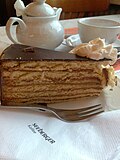
|
Cake | A cake that consists of seven thin cake layers with chocolate buttercream in between. |
| Topfenstrudel | 
|
Cake | Similar to Apfelstrudel, but filled with topfen instead, and served with vanilla sauce. |
| Dampfnudel | 
|
Main course | A sort of white bread or steam noodle made of yeast dough, steamed in a pan and then served with various toppings, e.g. sugar, cinnamon, poppy seeds, jam, butter, and vanilla sauce. |
| Buchteln | 
|
Main course | Sweet dumplings made of yeast dough, filled with jam, poppy seed paste, or curd, and baked in a large pan so that they stick together. The traditional Buchtel is filled with plum jam. Buchteln are topped with vanilla sauce, powdered sugar, or eaten plain and warm. |
| Obatzda | 
|
Side dish | a Bavarian cheese delicacy that is prepared by mixing two thirds aged soft cheese, usually Camembert (Romadur or similar cheeses may be used as well), and one third butter. |
| Limburger | 
|
Cheese | A cheese that originated during the 19th century in the historical Duchy of Limburg, which is now divided between Belgium, Germany, and the Netherlands. The cheese is especially known for its strong smell caused by the bacterium Brevibacterium linens. |
| Tafelspitz | 
|
Side dish | A boiled veal or beef in broth, served with a mix of minced apples and horseradish. It is a classic dish of the Viennese cuisine and popular throughout Austria and the neighboring German state of Bavaria. |
Berlin[edit]
| Name | Image | Type‡ | Description |
|---|---|---|---|
| Akvavit | 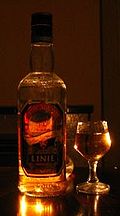
|
Beverage | A distilled spirit that is principally produced in Scandinavia, where it has been produced since the 15th century. Akvavit is distilled from grain and potatoes, and is flavoured with a variety of herbs. Akvavit is also popular in Germany and the American Midwest. |
| Berliner Luft | 
|
Beverage | A type of mint liqueur produced in Berlin. |
| Beamtenstippe [de] | 
|
Sauce | A either white or brown sauce that is eaten with potatoes. |
| Berliner Weisse | Beer | A cloudy, sour beer of around 3% alcohol by volume. It is a regional variation on the white beer style from Northern Germany, dating back to at least the 16th century. | |
| Buletten | 
|
Main course or snack | A kind of meatball in Berlin. |
| Currywurst | 
|
Snack | A hot pork sausage served either with curry ketchup or a tomato paste with curry powder. |
| Dinkelbrot [de] | 
|
Bread | The name for a bread made in Germany from at least 90% spelled malt products or spelt. |
| Eierkuchen | 
|
Main course | A generally thicker pancake than a French-style crêpe and usually served with sweet or, occasionally, savory fillings. |
| Eisbein | 
|
Main course | Ham hock usually served with pea purée and Sauerkraut. |
| Hackepeter | 
|
Snack | Raw ground pork or mett that is spiced with salt and pepper, garlic and caraway. |
| Berliner Pfannkuchen | 
|
Pastry | Sweet dough dumplings, fried in fat or oil, filled with jam and glazed with confectioner’s sugar. Also known simply as «Berliner» or, in the eastern part of Germany, including Berlin itself, «Pfannkuchen» and in Bavaria, they are called «Krapfen». |
Bremen and Lower Saxony[edit]
| Name | Image | Type | Description |
|---|---|---|---|
| Birnen, Bohnen und Speck | 
|
Main course | A dish of pears, beans and bacon, invariably accompanied by potatoes. |
| Bratwurst | 
|
Snack | A grey sausage with veal content that has a mild flavor, is pan-fried and then eaten with a hard roll. |
| Braunschweiger | 
|
Snack | An internationally known sausage that is spread on toast or used in sandwiches. |
| Bregenwurst | 
|
Snack | A specialty sausage, usually served with Grünkohl |
| Bremer Kükenragout [de] | Main course | A ragout made from different kinds of meat and seafood as well as vegetables; may contain no chicken and if it does it’s meat from very young chicken. | |
| Brunswick Mum | 
|
Beverage | An ancient beer from Brunswick. |
| Butterkuchen | 
|
Cake | A sheet cake made from yeast dough topped with blops of butter and sugar. |
| Calenberger Pfannenschlag | 
|
Snack | Groats that are broiled and eaten with potatoes or on bread with various other side dishes, e.g. pickles or red beet; special kind of Knipp. |
| Gose | 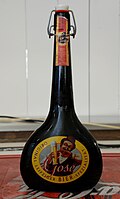
|
Beverage | A top-fermented beer that originated in Goslar, Germany. It is brewed with at least 50% of the grain bill being malted wheat. |
| Jägermeister | 
|
Beverage | A digestive made with 56 herbs and spices at a strength of 35% alcohol by volume (61 degrees proof, or US 70 proof). It is the flagship product of Mast-Jägermeister SE, headquartered in Wolfenbüttel, south of Braunschweig, Lower Saxony, Germany. |
| Kassler | 
|
Main course | A slowly cooked salted pork dish that is usually served with Knödel and Sauerkraut or potato salad. |
| Liverwurst | 
|
Snack | A kind of sausage made from the livers of pigs or calves. |
| Kluntjes | 
|
Candy | Sugar crystals that are used as sweetener for tea. |
| Knipp | 
|
Snack or Main course | Broiled groat sausage. |
| Labskaus | 
|
Snack or Main course | A dish made from corned beef, herring, mashed potatoes, and beetroot, served with a fried egg and a pickled cucumber. |
| Mettwurst | 
|
Snack | A strongly flavored German sausage, made from raw minced pork which is preserved by curing and smoking, often with garlic. |
| Nordseegarnelen | 
|
Snack or Main course | Prawns from the North Sea. |
| Pinkel mit Grünkohl | 
|
Main course | A dish made from slowly cooked kale that is served with Pinkel, a rather salty sausage. |
| Pottwurst | 
|
Snack | Another kind of Knipp. |
| Ratzeputz | Beverage | A type of spirit popular in Germany, which contains extracts and distillates of root ginger. The fresh ginger it contains is said to be beneficial to the stomach. | |
| Räucheraal [de] | 
|
Main course or snack | Smoked eel that is used as ingredient in various dishes. |
| Schlachteplatte | 
|
Snack | A dish with a variety of meats usually eaten as second breakfast. |
| Spargel | 
|
Side dish | White asparagus that is eaten as a delicacy, commonly with potatoes and Sauce hollandaise. |
| Speck | 
|
Snack | An English word meaning «fat», attested since the early 17th century. This word also exists in German with the same meaning, but it normally refers to pork fat with or without some meat in it. |
| Steckrübeneintopf | 
|
Main course | A hearty stew made from rutabagas, carrots, and potatoes. |
| Welf pudding | Dessert | A sweet two-layer pudding invented by a royal chef with one layer of vanilla-based and one of wine-based pudding. | |
| Wurstbrühe [de] | 
|
Soup | The broth, which arises in the production of brewing and cooking sausage. At the traditional slaughterhouse, the meat and liver were also cooked in the same cauldron before the sausages, which produced a strong broth, especially when later sausages burst, which formed the basis. |
East Prussia[edit]
East Prussia, as Germany’s easternmost province, was very often influenced by the cuisines of its surrounding neighbours: Russia and Lithuania to the northeast, and Poland to the south. The Russian borscht was adapted to the East Prussian palate, and Polish sausages were frequently found on the dinner table.
East Prussia’s gastronomy also made extensive use of the abundant products from its dark, remote forests. Honey was often incorporated into recipes, and Kopskiekelwein, a fruit wine made from wild currants, was the favourite regional tipple alongside beer.
| Name | Image | Type | Description |
|---|---|---|---|
| Bärenfang | 
|
Beverage | A German honey-flavoured liqueur based on vodka. It is usually called Bärenjäger in English-speaking countries. |
| Beetenbartsch | 
|
Soup | A beetroot-based soup served with sour cream (Schmand) and beef (originally from Ukraine) |
| Kuttelsuppe [de] | 
|
Soup | A lightly bound soup from tripe, usually with acidified vinegar that mentions regional spots, which is common in variants in numerous countries. |
| Königsberger Klopse | 
|
Main course | Meatballs served in a white sauce with capers and eaten with potatoes. |
| Königsberger Marzipan | 
|
Candy | Special kind of marzipan made in Königsberg. |
| Kopskiekelwein | 
|
fruit wine | A wine made from either blackcurrants or redcurrants, and usually fermented with Burgundy yeast. |
| Pillkaller Machandel | 
|
Beverage | A clear liqueur that is served in a drink with liver sausage and mustard. |
| Schwarzsauer | Soup | A type of blood soup with various spices cooked in vinegar-water. | |
| Spirgel [de] | Snack | The East Prussian name for fried bacon or pork belly as well as for a simple dish of diced pancetta or pork belly and onions. | |
| Tilsiter cheese | 
|
Cheese | A light yellow semi-hard smear-ripened cheese, created in the mid-19th century by Prussian-Swiss settlers, the Westphal family, from the Emmental valley. |
Franconia[edit]
| Name | Image | Type | Description |
|---|---|---|---|
| Fränkische Bratwurst | 
|
Snack | Fränkische Bratwurst is composed of beef, pork or veal and is traditionally served with sauerkraut or potato salad or simply in a breadroll. They vary greatly in size and seasoning from region to region but are often considerably thinner than the equivalents elsewhere in Germany. The best-known sausages are from Nuremberg (Nürnberg) and are recognisable by their small size and clearly visible herb seasoning. They are traditionally served as three sausages in a roll («Drei in ‘a Weckla») or six sausages on sauerkraut («Sechs auf Kraut»). |
| Drei im Weggla | 
|
Sandwich | A sandwich that has three items in a roll, typically three sausages or sausage pieces. |
| Extrawurst | 
|
Snack | A type of Austrian scalded cold cut that is moist, light colored, fine textured and made from a well-spiced mixture of beef, pork and bacon fat. In Austria, it is the most popular type of cold cut. |
| Kartoffelklöße [de] | 
|
Main course | Large klöße made from a dough consisting of raw or a combination of raw and cooked potatoes. The exact recipe is a matter of regional differences and personal belief. The best friend of pot-roasted meats or mushroom ragout. |
| Pressack mit Musik | 
|
Main condiment | a cold cut that originated in Europe that literally means head cheese with music. |
| Saure Zipfel | 
|
Main course | A typical dish of the cuisine of Franconia and Upper Palatinate that consists of Bratwurst and sliced onion cooked in vinegar and usually eaten with Bavarian pretzels. |
| Schäufele | 
|
Main course | An entire pork (or, in some cases, Lamb) shoulder roasted in a fairly cool oven over long period so that the meat is extremely tender with a crunchy crust. Seasoning is usually simple using salt, pepper and caraway and traditionally it is served in a dark sauce, made from the roast stock, meat broth, and often dark beer and Lebkuchen spices. Accompanied by a side salad, dumplings and red cabbage or less commonly sauerkraut. |
| Stadtwurst | 
|
Snack | A type of sausage consisting of pork in a casing that may be white or red. Stadtwurst is a regional variety in Franconia and Upper Palatinate (Oberpfalz) and usually unknown and not available in other parts of Germany. |
| Hochzeitssuppe | 
|
Soup | A spicy wedding soup with bread dumplings, liver dumplings and finely sliced pancakes. |
| Lebkuchen | 
|
Pastry/Cookie | German kind of gingerbread of which the most famous originates in Nuremberg and is traditionally only available at Christmas, although tourist demand means that Lebkuchen are available in some form practically all year round. |
| Regensburger Wurst | 
|
Snack | A boiled sausage with a fine or coarse pork filling that comes in a compact shape with a length of about 10 cm (4 in) and a diameter of about 4 cm. It was invented in Regensburg in the second half of the 19th century and only sausages that are produced in the inner city ring may be called «Regensburger». |
| Weihnachtskarpfen [de] | 
|
Main course | A traditional dish with breaded and fried carp for Christmas Eve in Central Europe. |
| Wickelklöße [de] | Snack | A variant of the potato dumpling of the Erzgebirge cuisine and Thuringian cuisine filled with breadcrumbs. | |
| Wurstsalat | 
|
Main course | A tart sausage salad prepared with distilled white vinegar, oil and onions.[1][2] A variation of the recipe adds strips of pickled gherkin. |
Frankfurt am Main and Hessen[edit]
| Name | Image | Type | Description |
|---|---|---|---|
| Nürnberger Rostbratwurst | 
|
Snack | The small, thin bratwurst from Franconia’s largest city, Nuremberg, was first documented in 1567; it is 7 to 9 cm (2.8 to 3.5 in) long, and weighs between 20 and 25 g. |
| Green Sauce | 
|
Dip | A bright sauce made from an abundant amount of seven fresh minced herbs namely borage, sorrel, cress, chervil, chives, parsley, and burnet. Served with boiled potatoes and hardboiled eggs. Called «Grüne Soße» in German or «Griee Sooß» in the Hessian dialect. |
| Frankfurter sausage | 
|
Snack | A smoked sausage made from pure pork, which is eaten hot and usually accompanied by bread and mustard. Not to be confused with the American hot dog «Frankfurter». |
| Fischmilch [de] | 
|
Main course | Milt that is fresh or preserved with salt as food and is used for flavoring sauces or used in whole fish dishes. |
| Apfelwein | 
|
Beverage | A wine made of apples, somewhat comparable to Cider and French Cidre though dryer and more sour-tasting. Best enjoyed in traditional «Äbbelwoi-Lokalen». Served from a special jug (the «Bembel»), drunk with a special glass (the «Gerippte»). |
| Schorle | 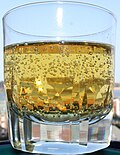
|
Beverage | A refreshing drink that combines apple juice with sparkling water. It is usually served during summer. |
| Handkäse | 
|
Cheese | A German regional sour milk cheese and a culinary speciality of Frankfurt am Main, Offenbach am Main, Darmstadt, Langen, and other parts of southern Hesse. It gets its name from the traditional way of producing it: forming it with one’s own hands. |
| Harzer | 
|
Cheese | A German sour milk cheese made from low fat curd cheese, which contains only about one percent fat and originates in the Harz mountain region south of Braunschweig. |
| Mainzer Kaese [de] | 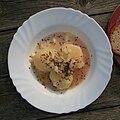
|
Snack | A sour milk cheese, similar to the Harzer or hand cheese. It was invented in 1813 by a farmer’s wife named Kaul in Groß-Gerau and sold at the weekly market in Mainz. |
Hamburg[edit]
| Name | Image | Type | Description |
|---|---|---|---|
| Knackwurst | 
|
Snack | A sausage type of northern German origin from the mid-16th century. The manifold available varieties depend on the geographical region of their production. |
| Hamburger Speck | 
|
Dessert | A type of candy made out of foamed sugar with various coatings. The colors of the candy are often the same as the colors of Hamburg’s flag (red and white), with a white central square and two red outer squares. |
| Labskaus | 
|
Main course or snack | A dish made from corned beef, herring, mashed potatoes, and beetroot, served with a fried egg and a pickled cucumber. See also under Bremen and Lower Saxony. |
| Marmorkuchen | 
|
Cake | A cake with a streaked or mottled appearance (like marble) achieved by very lightly blending light and dark batter. |
| Birnen, Bohnen und Speck | 
|
Main course | A dish composed of pears, beans, and bacon, invariably accompanied by potatoes. |
| Hamburger Aalsuppe [de] | 
|
Soup | A sweet and sour soup of eel, meat broth, dried fruits, vegetables, and herbs. |
| Franzbrötchen | 
|
Pastry | A pastry made from Phyllo dough, covered with sugar and powdered cinnamon that is usually eaten for breakfast. It literally means «Frenchman’s roll» and is only rarely found outside of Hamburg, Germany. |
| Frikadelle | 
|
Main course or snack | A type of flat meatball composed of pork, beef and onions commonly eaten with pasta salad, potatoes or simply in a bread roll with mustard or other condiments. |
| Hamburger Hummersuppe | 
|
Soup | A creamy lobster soup served with a small amount of whipped cream and garnished with dill. |
| Hamburger Krabbensuppe | Soup | A creamy shrimp soup served with a small amount of whipped cream and garnished with dill. | |
| Heißewecken [de] | 
|
Main course or snack | A traditional pastry that has been proven in German-speaking since the late Middle Ages and was eaten in north and northwest Germany before the beginning of the pre-Easter Lent, especially from Rose Monday to Ash Wednesday. |
| Krabbentoast [de] | 
|
Main course or snack | A bread dish that is made with vegetables and shrimp. |
| Rote Grütze | 
|
Dessert | A jelly/jam-like dessert or summer dish made from berries especially currants that can be eaten pure, but is often accompanied by milk or vanilla sauce. |
Mecklenburg-Vorpommern[edit]
| Name | Image | Type | Description |
|---|---|---|---|
| Mecklenburger Rippenbraten [de] | 
|
Main course | Rib roast, made from belly of pork including meat of the upper rib, stuffed with Boskoop apples, prunes, cinnamon, rum and zwieback, usually served with Klöße and red cabbage. |
| Tüffel un Plum | Main course | A potato stew made with smoked ham, prunes, potatoes and spiced with clove and bay leaves. | |
| Fliederbeersuppe [de] | 
|
Dessert | Dessert soup made from elderberry, served with semolina dumplings |
| Sahnehering [de] | 
|
Main course | Young herring marinated in cream, with onions and sometimes pears or apples and served with Bratkartoffeln or Pellkartoffeln. |
| Schwedeneisbecher [de] | 
|
Dessert | A Swedish ice cup with vanilla ice, served with apple sauce, whipped cream and a waffle, optionally with advocaat liquor. |
Palatinate[edit]
| Name | Image | Type | Description |
|---|---|---|---|
| Gequellde mit weißem Kees [de] | Main course | A dish of cooked potatoes with curd cheese. | |
| Pälzer Lewwerworschd [de] | 
|
Main course | A dried sausage in the curry and the palate, the cheese is made from cereals, as well as the shrub, salt, garments, and croissants, of the marginal downy marrow, which is breeding — a lot of peasants are typical and bred. |
| Saumagen | 
|
Main course | A pork’s stomach that serves as casing for a filling of pork, sausage meat and potatoes. Sometimes the filling also contains eggs and carrots. The dish is usually served with mashed potatoes and sauerkraut, bread or Bratkartoffeln. |
| Weck, Worscht, un Woi [de] | 
|
Snack | A widespread meal with a bread roll, a sausage, and wine in the wine-growing regions of Pfalz, Rheinhessen, Hessische Bergstraße, and Rheingau, where the sausage is always enjoyed cold. |
| Grumbeersupp un Quetschekuche | 
|
Main course | Potato soup and plum tart |
| Kirschenmichel | 
|
Dessert | Kind of cherry cake or bread pudding made with cherries and usually served hot with vanilla sauce. |
| Zwiebelkuchen | 
|
Main course | An onion pie usually served with Federweisser. |
| Federweisser | 
|
Beverage | Young white wine. |
| Kuemmerling | 
|
Beverage | A type of Kräuterlikör (herb liqueur) from Germany, belonging to the group of Halbbitter (semi bitters). |
| Chestnuts | 
|
Side dish | Cooked chestnuts served with meat or other things. |
Rhineland[edit]
| Name | Image | Type | Description |
|---|---|---|---|
| Rheinischer Sauerbraten | 
|
Main course | Large pieces of beef or more traditionally horse meat, marinated in a spicy water-vinegar mixture for a long time before baking. |
| Reibekuchen | 
|
Side dish | Potato fritter with black bread, apple syrup, sugar beet syrup, or stewed apples. |
| Blutwurst | 
|
Snack | Blood sausage either cured or fried. |
| Himmel und Erde | 
|
Main course | A dish with mashed potatoes with stewed apples and fried blood pudding (Cologne) that literally means, «Heaven/Sky and Earth». Potatoes are also called ‘Erdäpfel’, what means ‘ground apples’, so it is a meal prepared out of ‘apples’ which grow above and under the earth. |
| Halve Hahn [de] | 
|
Snack | A dish that literally means, «Half Cockerel», but does not actually contain rooster at all. It is a cheese sandwich with a thick slice of extra matured Gouda cheese, onions and mustard on a Röggelchen. The name is based on a wordplay (Köln). |
| Muscheln Rheinischer Art | 
|
Main course | Mussels cooked in wine with vegetables and served with whole wheat bread and some butter. |
| Killepitsch | 
|
Beverage | A herb liqueur from Düsseldorf, Germany. It is a blood red colour and is flavoured with fruits, berries, herbs, and spices. Its alcohol content is 42% by volume. |
| Korn | 
|
Beverage | A German colourless distilled beverage produced from fermented cereal grain seed. |
| Marillenschnaps | 
|
Beverage | A fruit brandy made from apricots. It is mostly produced in the Wachau region of Austria, but similar apricot brandies are produced elsewhere |
| Underberg | 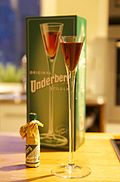
|
Beverage | A digestive bitter produced at Rheinberg, Germany by Underberg AG, made from aromatic herbs from 43 countries, which undergo inspections and are based on a secret Underberg family recipe whose members are personally responsible for the production of the drink. |
| Zwetschgenwasser [de] | 
|
Beverage | A plum brandy obtained by distilling fermented plums. |
Saarland[edit]
| Name | Image | Type | Description |
|---|---|---|---|
| Dibbelabbes [de] | 
|
Main course | A potato hash prepared from raw grated potatoes, bacon and leeks, and baked in a Dibbe, or pot, usually eaten with apple sauce. |
| Schwenker | 
|
Main course | Pork steaks, marinated in spices and onions and broiled on a grill that hangs on a chain over a wood fire). |
| Geheirate | 
|
Main course | Married potatoes and dumplings made of flour served with a creamy bacon sauce. |
Saxony[edit]
| Name | Image | Type | Description |
|---|---|---|---|
| Eierschecke | 
|
Cake | A cake consisting of three layers: The bottom one is either a yeast dough (Hefeteig) or one made with baking soda (Rührteig), the middle layer is a cream made of quark, vanilla and some butter, egg, sugar and milk, and the top layer is mainly made from eggs (Eier), which are beaten with butter, sugar and «Vanillepudding»-powder (starchy substance normally used to cook a dessert similar to semolina pudding). |
| Leipziger Allerlei | Side dish | A vegetable dish consisting of peas, baby carrots, white asparagus and morels. It may also, but not necessarily, contain broccoli, cauliflower, green beans or corn, even small prawns. | |
| Quarkkeulchen | 
|
Main course or dessert | A sweet main dish made from quark, mashed boiled potatoes, a little flour, an egg and some grated lemon peel. The ensuing dough is baked as small, less than palm-sized pancakes and eaten hot with sugar and cinnamon, or with fruit, whipped cream, vanilla ice cream etc. |
| Schälklöße | Soup | A soup that consists of filled pasta and various vegetables. | |
| Stollen | 
|
Cake | German Christmas cake of which there are two important centers in Saxony: Dresden and the Ore Mountains. |
| Teichelmauke [de] | 
|
Main course | A dish that consists of mashed potatoes with bouillon and cooked beef. |
Note: The cuisine of the Saxon part of the Ore Mountains is more a relative of the cuisine of Franconia than a relative of the other parts of Saxony. The cuisine of Upper Lusatia also differs from central Saxony and is more related to the (former) cuisines of Lower Silesia and Northern Bohemia.
Saxony-Anhalt[edit]
Typical for very traditional dishes from Saxony-Anhalt is the combination of bitter or hearty meat dish with sweet. Sweet pancakes in Green bean soup for example are the cause of many jokes.
| Name | Image | Type | Description |
|---|---|---|---|
| Baumkuchen | 
|
Cake | A cake typical for Christmas that is very difficult to prepare. |
| Magdeburger Schmalzkuchen [de] | 
|
Pastry | Fried pastry made from yeast dough, topped with confectioner’s sugar and usually consumed for carneval. |
| Eisbein | 
|
Main course | Ham hock that is usually served with mashed potatoes or bread and sauerkraut. |
| Schierker Feuerstein | 
|
Beverage | A herb liqueur. |
| Rotkäppchen Sektkellerei [de] | 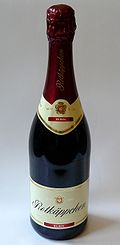
|
Beverage | A brand of sparkling wine. |
Schleswig-Holstein[edit]
| Name | Image | Type | Description |
|---|---|---|---|
| Buttermilchsuppe | Soup | Buttermilk soup with flour dumplings | |
| Gruenkohlgericht | 
|
Side dish | Cooked kale usually served with potatoes and Kasseler or other foods. |
| Kieler Sprotten | 
|
Main course | Smoked Baltic sprats. |
| Labskaus | 
|
Main course or snack | A dish made from corned beef, herring, mashed potatoes, and beetroot, served with a fried egg and a pickled cucumber. |
| Mehlbeutel [de] | 
|
Main course | A large flour dumpling served with bacon and a sweet sauce. |
| Schnüüsch [de] | Main course | A stew made of ham, potatoes and vegetables cooked in roux. | |
| Schwarzsauer | Soup | A sort of black pudding made with vinegar. | |
| Snuten un Poten [de] | 
|
Main course | Cured pig snouts and trotters that are cooked in vinegar together with several spices. Traditionally served with sauerkraut, erbspüree, and hot mustard. |
Silesia[edit]
When Silesia was German, the influence of neighboring countries was clear in Silesian cooking; Polish carp and cheeses, Bohemian goulash, Austrian sausage and Pfefferkuchen (pepper cakes). Schnapps was very commonly drunk with beer in Silesia. There was an old saying that went «Silesia has two principal rivers, Schnapps and the river Oder».
| Name | Image | Type | Description |
|---|---|---|---|
| Schlesisches Himmelreich [de] | 
|
Main course | A dish of pork belly with dried fruits and cinnamon that literally means, «Silesian Heaven». |
| Kartoffelsuppe [de] | 
|
Soup | A potato soup of the traditional German and Austrian cuisine that has the main ingredient of potatoes. If the consistency is relatively viscous, then it is called a potato stew. |
| Weihnachtsgans [de] | 
|
Main course | Roasted goose traditionally served with potatoes or Klöße with gravy and vegetables. |
| Schlesische Kartoffelklöße [de] | 
|
Main course | Silesian potato dumplings. |
| Schlesische Küche [de] | 
|
Cake | A flat Silesian cake of fine yeast dough with a topping of crumbles, a crumbly mixture of sugar, fat, and flour. |
| Mohnkuchen [de] | 
|
Cake | A generic term for various types of cakes, which have in common that they contain poppy seeds or the seeds of blue or gray grapes, either in the dough or in the form of a pad or filling. |
| Streuselkuchen | 
|
Cake | A German specialty that is traditionally made of a yeast dough and covered with a sweet crumb topping referred to as streusel. |
| Liegnitzer Bombe [de] | 
|
Cake | A gingerbread specialty from Liegnitz in Lower Silesia that is a small round cake made of brown gingerbread dough with a fruit and marzipan filling. |
| Stonsdorfer [de] | 
|
Beverage | A type of herb liqueur, originally made in Staniszów (Stonsdorf). |
Thuringia[edit]
| Name | Image | Type | Description |
|---|---|---|---|
| Thuringian sausage | 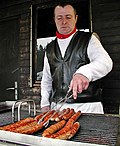
|
Snack | Red to grey, stuffed in a natural casing of pig intestine, unlike the white Franconian variety. |
| Thüringer Rostbrätel | 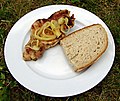
|
Main course | A pork neck steak marinated together with onions in beer and mustard. |
| Thüringer Klöße | 
|
Main course | Dumplings made of raw or cooked potatoes with pan-fried toasted bread inside. |
| Mutzbraten [de] | 
|
Main course or snack | A pound of mutton, roasted on open birchwood fire, served with sauerkraut. |
| Rinderroulade | 
|
Main course | Beef roulades: Spread with mustard and filled with bacon, onions and (in some areas) pickled cucumber. |
| Käsekuchen | 
|
Cake | Cheesecake made from quark (cheese) either with or without pie crust (usually shortcrust pastry). |
| Schmandkuchen [de] | 
|
Cake | A sheet cake that consists of yeast dough and a layer of fruit or quark, which in turn is covered by a layer of sour cream, pudding, or porridge. The top layer is a made of cinnamon on the sour cream cake. |
| Prophetenkuchen [de] | 
|
Cake | A speciality cake from Altenburg that consists of eggs, sugar, oil, flour, and alcohol (usually rum). |
| Zwiebelkuchen | 
|
Cake (savoury) | A sheet cake made in Weimar from yeast dough with onions, sour cream, bacon bits and eggs. |
Westphalia[edit]
| Name | Image | Type | Description |
|---|---|---|---|
| Blindhuhn | 
|
Stew | A stew of the Westphalian cuisine prepared with beans, vegetables and bacon |
| Kassler | 
|
Side dish | The name given to a salted (cured) and slightly smoked cut of pork similar to British gammon. It can be either hotly or coldly smoked. |
| Knieperkohl | 
|
Main course | A pickled cabbage dish similar to sauerkraut. It contains not only white cabbage but also collard greens (or leaves of red cabbage) and kale, as well as grape leaf and cherry leaf. |
| Pickert | 
|
Main course | Potato pancakes |
| Kohlwurst | 
|
Main course | A simple, fresh, strongly smoked sausage (Rohwurst) made of lights, pork and fat, which is mostly eaten cooked with kale (cabbage) dishes. |
| Westphalian ham | 
|
Snack | A hearty and smoked ham from Westfalen that is very aromatic. |
| Möpkenbrot | 
|
Snack | A kind of blood sausage that contains rye bread, pig-blood, milk, eggs, fat, salt, and pepper. |
|
Pfefferpotthast |
Main Course | A meat dish consisting of beef, lard, onions, and spices, cooked in a pot; and served with boiled potatoes and salad in the summer, and pickled cucumbers and beetroot in the winter. | |
| Rump steak | 
|
Main course | Roast beef served with various sides such as potato wedges and vegetables. |
| Pumpernickel | 
|
Bread | A hearty bread; it goes black because the sugar in the bread goes to caramel. |
| Herrencreme | 
|
Dessert | A gentleman’s creme that consists of vanilla jelly with cream and rum. |
| Spanish fricco | Stew | A hearty Westphalian stew prepared primarily using diced beef, potatoes and onions, typically in a cream soup base | |
| Stippgrütze | 
|
Snack | Barley groats cooked in sausage juices (Wurstbrühe), which are enriched with pieces of meat, offal, such as heart, kidney or liver and seasoned with spices and salt. The cooked ingredients are minced after the juices have been poured off and a crumbly cake is left which is held together with fat and which sets on cooling. |
See also[edit]
- German cuisine
- German fries
- List of German cheeses
- List of German desserts
- List of German soups
References[edit]
- ^ «Was essen Sie üblicherweise am 1. Weihnachtsfeiertag?». Statista.com. Retrieved 2018-05-25.
From Wikipedia, the free encyclopedia
Below is a list of dishes found in German cuisine.
Famous dishes[edit]
| Name | Image | Region | Description |
|---|---|---|---|
| Aachener Printen | 
|
Aachen | A type of gingerbread that is typical for the city of Aachen. |
| Apfelkuchen | 
|
Throughout Germany | German pastry consisting of sliced apples |
| Bratkartoffeln | 
|
Throughout Germany | Fried potato slices, often with diced bacon or onions |
| Bratwurst | 
|
Throughout Germany | Sausage that is usually composed of veal, pork or beef. It is a traditional German sausage. Not to be confused with curry wurst. |
| Currywurst | 
|
Berlin, Rhine-Ruhr | This large-format, fried or grilled wiener is cut into thick slices and seasoned with spicy ketchup and generous amounts of curry powder, usually served with french fries — a popular snack originating in early 1950s Berlin. Both Bockwurst-style (i.e. intended to be boiled) and Bratwurst-style (i.e. intended to be grilled or fried) sausages are used, depending on region, and the use of one or the other is a matter for much debate among Currywurst gourmets. Currywurst remains one of the most popular fast foods in Germany, especially in Berlin and the Rhine-Ruhr area, but the Döner kebab is gaining rapidly in popularity. |
| Fischbrötchen | 
|
Northern Germany | Sandwich made with various fish (pickled or fried) and onions, common in Northern Germany, particularly along the coast |
| Hendl | 
|
Austro-Bavarian | Whole grilled chicken marinated with pepper and other spices this dish is known as Brathühnchen, Brathähnchen, and in eastern Germany, also as Broiler. |
| Hasenpfeffer | A stew made from marinated rabbit | ||
| Kartoffelsalat | 
|
Northern Germany and South Germany | Potato salad, which comes in many varieties, for example in a cream or mayonnaise dressing (northern Germany) or even in meat broth (south Germany), is often served as a side dish to Bratwurst or boiled sausages). |
| Knödel (also known as Kloß, depending on region) | 
|
Throughout Germany | German dumplings; many different variations:
|
| Königsberger Klopse | 
|
East-Prussian: city of Königsberg | Cooked meatballs served in a white sauce with capers |
| Kohlroulade | 
|
Throughout Germany | German-style cabbage rolls |
| Marzipan | 
|
Throughout Germany | E.g. Lübeck-style, widely used in Christmas specialities |
| Pellkartoffel [de] | 
|
Throughout Germany | Boiled or steamed potatoes before peeling (young potatoes may be eaten unpeeled), served with Quark and linseed oil, butter, or as a side dish with herring). |
| Pfefferpotthast | Westphalia | A traditional peppered beef stew of the German cuisine that belongs to the cuisine of Westphalia. | |
| Rinderroulade | 
|
Throughout Germany | A roulade of bacon and onions wrapped in thinly sliced beef |
| Sauerbraten | 
|
Rhineland | A beef pot roast marinated in vinegar, water, spices and seasonings |
| Sauerkraut | 
|
Throughout Germany | Fermented shredded cabbage |
| Schnitzel | Throughout Germany | Fried, breaded thin piece of meat, typically pork or beef | |
| Schweinshaxe | 
|
Pork hock served grilled and crispy with Sauerkraut or boiled as Eisbein | |
| Spanferkel | 
|
Throughout Germany | A grilled whole young pig, usually eaten in a large company of friends or guests |
| Speckpfannkuchen | Large, thin pancakes with diced, fried bacon | ||
| Spätzle | 
|
Southern Germany | These hand-made noodles are very popular and are an important ingredient of several dishes, such as Linsen mit Spätzle or Käsespätzle. |
| Stollen | 
|
Dresden | A bread-like cake with dried citrus peel, dried fruit, nuts, and spices such as cardamom and cinnamon; it is usually eaten during the Christmas season as Weihnachtsstollen or Christstollen. The best-known Stollen is from Dresden and is sold at the Striezelmarkt Christmas market, which derives its name from the cake. |
| Weihnachtsgans | 
|
Throughout Germany | A roasted goose is a popular dish on Christmas Day.[1] |
Baden-Württemberg[edit]
| Name | Image | Type | Description |
|---|---|---|---|
| Maultaschen | 
|
Main course | Noodle filled with various ingredients, such as meat, spinach, onions, spices: Maultaschen are either served with broth or cut into slices and fried with eggs. |
| Brenntar | 
|
Main course | It is made of roasted flour called Musmehl, usually spelt flour or oat flour. It is usually cooked like a porridge with water and milk with various ingredients. |
| Sauerbraten | 
|
Main course | A vinegar-marinated roast traditionally made of horse meat, although nowadays the majority is made of beef. |
| Filderkraut [de] | 
|
Side dish | A finely cut pointed white cabbage that has been fermented by various lactic acid bacteria. |
| Spätzle | 
|
Pasta | A kind of soft egg noodle found in the cuisines of southern Germany and Austria, Switzerland, Hungary, Moselle and South Tyrol. |
| Linsen mit Spätzle | 
|
Main course | Hearty dish that combines Spätzle with cooked lentils and Vienna sausages. |
| Schupfnudel | 
|
Pasta | Pasta made from potatoes and flour, often served with Sauerkraut. |
| Flädlesuppe | 
|
Entree | A broth with thin strips of German-style pancakes. |
| Springerle | 
|
Snack | Cookies made by pressing dough into intricate molds. Commonly used for dunking into a drink, as they are quite hard. |
| Zwiebelkuchen | 
|
Main course | An onion cake, a seasonal dish served around October, usually eaten while still warm and accompanied by slightly fermented red or white grape juice called Süser or (more commonly in other regions) Federweißer. |
| Flammkuchen | 
|
Main course | A pizza-like dish with thin crust and onion, bacon and crème fraîche topping. |
| Gaisburger Marsch | 
|
Main course | A famous stew made of meat, potatoes, Spätzle and several kinds of vegetables like potatoes and carrots. |
| Käsespätzle | 
|
Main course | Dish of Spätzle and fried onions gratinated with cheese. |
| Wibele | 
|
Snack | Small, sweet biscuits. |
| Himbeergeist | 
|
Beverage | A fruit-based Schnapps produced mainly in Germany and the Alsace region of France. |
| Kirschwasser | 
|
Beverage | A clear, colorless fruit brandy traditionally made from double distillation of morello cherries, a dark-colored cultivar of the sour cherry. |
Bavaria[edit]
| Name | Image | Type | Description |
|---|---|---|---|
| Bierwurst | 
|
Coldcuts | A German cooked, smoked Brühwurst sausage originally from Bavaria, with a garlicky flavor and dark red color. It is seasoned with black peppercorns, paprika, and mustard seeds for flavor. |
| Blutwurst | 
|
Coldcuts | A type of blood sausage originating in Bavaria. |
| Brotzeit | 
|
Main course | A traditional German savory snack native to the Bavarian cuisine and it literally means «Bread time». |
| Weißwurst | 
|
Snack | Lt.:’White sausages’; a speciality from Munich, traditionally eaten for second breakfast. Always accompanied by sweet mustard, pretzels, and wheat beer. Traditionally not served after 12 noon because in earlier days, before fridges, the sausages had to be consumed before 12 noon so that they didn’t decay. But, nowadays, people also eat it for dinner or lunch. |
| Weizenbier | 
|
Beverage | A beer, usually top-fermented, which is brewed with a large proportion of wheat relative to the amount of malted barley. The two main varieties are Weissbier and Witbier; the minor types include Lambic, Berliner Weisse and Gose. |
| Helles | 
|
Beverage | A German beer style that is usually drunk in Bavaria, Germany. It has a yellow, gold color, and has 4.5-6% alcohol. |
| Radler | 
|
Beverage | A beer mixed with citrus lemonade |
| Kartoffelkäse | 
|
Side dish | A spread from the regions of Bavaria and Austria that literally means «Potato cheese». |
| Münchener Bier | 
|
Beer | A protected geographical indication for beer since 1998, which is brewed within the city limits of Munich by the breweries Augustiner Bräu, Spaten-Franziskaner-Bräu, Hacker-Pschorr, Paulaner, Hofbräu and Löwenbräu, which are members of the Münchner Brauereien. |
| Schweinsbraten [de] | 
|
Main course | Sliced pork roast with a crunchy crust that was boiled in a pot. |
| Schweinshaxe | 
|
Main course | Braised pork leg with a crunchy brown crust on the outside, and a moist and juicy inside. Served with gravy and Klöße. |
| Leberkäse | 
|
Snack | A type of sausage baked in a mould and cut into slices. When eaten as a main course, it is sliced and served with an egg (must be sunny side up style), and mashed potatoes. For a quick lunch, it is usually eaten in a bread-roll with mustard, a bit like a hotdog. Some people eat the Leberkäse with hot mustard, others with sweet mustard. |
| Leberknödel | 
|
Soup | A traditional dish of German, Austrian and Czech cuisines that literally means «Liver dumpling soup». |
| Schlachtschüssel | 
|
Snack | Lt.: Butchers plate; a combination of Blutwurst and Leberwurst (blood sausage and liver sausage), served hot on sauerkraut. |
| Saures Lüngerl [de] | Main course | A ragout from lung and sometimes heart from the veal. | |
| Bayrisch Kraut | 
|
Side dish | Shredded cabbage that is cooked in beef stock with pork lard, onion, apples, and seasoned with vinegar. |
| Kartoffelsalat | 
|
Side dish | Bavarian potato salad is usually made with broth, bacon bits and onions and may be served hot or chilled. |
| Pichelsteiner | 
|
Main course | A stew made from various kinds of meat and vegetables. |
| Bayrisch Creme | 
|
Dessert | A very light, fluffy, and not too sweet dessert made from gelatin, milk, cream, egg yolk, and sugar. |
| Prinzregententorte | 
|
Cake | A cake that consists of seven thin cake layers with chocolate buttercream in between. |
| Topfenstrudel | 
|
Cake | Similar to Apfelstrudel, but filled with topfen instead, and served with vanilla sauce. |
| Dampfnudel | 
|
Main course | A sort of white bread or steam noodle made of yeast dough, steamed in a pan and then served with various toppings, e.g. sugar, cinnamon, poppy seeds, jam, butter, and vanilla sauce. |
| Buchteln | 
|
Main course | Sweet dumplings made of yeast dough, filled with jam, poppy seed paste, or curd, and baked in a large pan so that they stick together. The traditional Buchtel is filled with plum jam. Buchteln are topped with vanilla sauce, powdered sugar, or eaten plain and warm. |
| Obatzda | 
|
Side dish | a Bavarian cheese delicacy that is prepared by mixing two thirds aged soft cheese, usually Camembert (Romadur or similar cheeses may be used as well), and one third butter. |
| Limburger | 
|
Cheese | A cheese that originated during the 19th century in the historical Duchy of Limburg, which is now divided between Belgium, Germany, and the Netherlands. The cheese is especially known for its strong smell caused by the bacterium Brevibacterium linens. |
| Tafelspitz | 
|
Side dish | A boiled veal or beef in broth, served with a mix of minced apples and horseradish. It is a classic dish of the Viennese cuisine and popular throughout Austria and the neighboring German state of Bavaria. |
Berlin[edit]
| Name | Image | Type‡ | Description |
|---|---|---|---|
| Akvavit | 
|
Beverage | A distilled spirit that is principally produced in Scandinavia, where it has been produced since the 15th century. Akvavit is distilled from grain and potatoes, and is flavoured with a variety of herbs. Akvavit is also popular in Germany and the American Midwest. |
| Berliner Luft | 
|
Beverage | A type of mint liqueur produced in Berlin. |
| Beamtenstippe [de] | 
|
Sauce | A either white or brown sauce that is eaten with potatoes. |
| Berliner Weisse | Beer | A cloudy, sour beer of around 3% alcohol by volume. It is a regional variation on the white beer style from Northern Germany, dating back to at least the 16th century. | |
| Buletten | 
|
Main course or snack | A kind of meatball in Berlin. |
| Currywurst | 
|
Snack | A hot pork sausage served either with curry ketchup or a tomato paste with curry powder. |
| Dinkelbrot [de] | 
|
Bread | The name for a bread made in Germany from at least 90% spelled malt products or spelt. |
| Eierkuchen | 
|
Main course | A generally thicker pancake than a French-style crêpe and usually served with sweet or, occasionally, savory fillings. |
| Eisbein | 
|
Main course | Ham hock usually served with pea purée and Sauerkraut. |
| Hackepeter | 
|
Snack | Raw ground pork or mett that is spiced with salt and pepper, garlic and caraway. |
| Berliner Pfannkuchen | 
|
Pastry | Sweet dough dumplings, fried in fat or oil, filled with jam and glazed with confectioner’s sugar. Also known simply as «Berliner» or, in the eastern part of Germany, including Berlin itself, «Pfannkuchen» and in Bavaria, they are called «Krapfen». |
Bremen and Lower Saxony[edit]
| Name | Image | Type | Description |
|---|---|---|---|
| Birnen, Bohnen und Speck | 
|
Main course | A dish of pears, beans and bacon, invariably accompanied by potatoes. |
| Bratwurst | 
|
Snack | A grey sausage with veal content that has a mild flavor, is pan-fried and then eaten with a hard roll. |
| Braunschweiger | 
|
Snack | An internationally known sausage that is spread on toast or used in sandwiches. |
| Bregenwurst | 
|
Snack | A specialty sausage, usually served with Grünkohl |
| Bremer Kükenragout [de] | Main course | A ragout made from different kinds of meat and seafood as well as vegetables; may contain no chicken and if it does it’s meat from very young chicken. | |
| Brunswick Mum | 
|
Beverage | An ancient beer from Brunswick. |
| Butterkuchen | 
|
Cake | A sheet cake made from yeast dough topped with blops of butter and sugar. |
| Calenberger Pfannenschlag | 
|
Snack | Groats that are broiled and eaten with potatoes or on bread with various other side dishes, e.g. pickles or red beet; special kind of Knipp. |
| Gose | 
|
Beverage | A top-fermented beer that originated in Goslar, Germany. It is brewed with at least 50% of the grain bill being malted wheat. |
| Jägermeister | 
|
Beverage | A digestive made with 56 herbs and spices at a strength of 35% alcohol by volume (61 degrees proof, or US 70 proof). It is the flagship product of Mast-Jägermeister SE, headquartered in Wolfenbüttel, south of Braunschweig, Lower Saxony, Germany. |
| Kassler | 
|
Main course | A slowly cooked salted pork dish that is usually served with Knödel and Sauerkraut or potato salad. |
| Liverwurst | 
|
Snack | A kind of sausage made from the livers of pigs or calves. |
| Kluntjes | 
|
Candy | Sugar crystals that are used as sweetener for tea. |
| Knipp | 
|
Snack or Main course | Broiled groat sausage. |
| Labskaus | 
|
Snack or Main course | A dish made from corned beef, herring, mashed potatoes, and beetroot, served with a fried egg and a pickled cucumber. |
| Mettwurst | 
|
Snack | A strongly flavored German sausage, made from raw minced pork which is preserved by curing and smoking, often with garlic. |
| Nordseegarnelen | 
|
Snack or Main course | Prawns from the North Sea. |
| Pinkel mit Grünkohl | 
|
Main course | A dish made from slowly cooked kale that is served with Pinkel, a rather salty sausage. |
| Pottwurst | 
|
Snack | Another kind of Knipp. |
| Ratzeputz | Beverage | A type of spirit popular in Germany, which contains extracts and distillates of root ginger. The fresh ginger it contains is said to be beneficial to the stomach. | |
| Räucheraal [de] | 
|
Main course or snack | Smoked eel that is used as ingredient in various dishes. |
| Schlachteplatte | 
|
Snack | A dish with a variety of meats usually eaten as second breakfast. |
| Spargel | 
|
Side dish | White asparagus that is eaten as a delicacy, commonly with potatoes and Sauce hollandaise. |
| Speck | 
|
Snack | An English word meaning «fat», attested since the early 17th century. This word also exists in German with the same meaning, but it normally refers to pork fat with or without some meat in it. |
| Steckrübeneintopf | 
|
Main course | A hearty stew made from rutabagas, carrots, and potatoes. |
| Welf pudding | Dessert | A sweet two-layer pudding invented by a royal chef with one layer of vanilla-based and one of wine-based pudding. | |
| Wurstbrühe [de] | 
|
Soup | The broth, which arises in the production of brewing and cooking sausage. At the traditional slaughterhouse, the meat and liver were also cooked in the same cauldron before the sausages, which produced a strong broth, especially when later sausages burst, which formed the basis. |
East Prussia[edit]
East Prussia, as Germany’s easternmost province, was very often influenced by the cuisines of its surrounding neighbours: Russia and Lithuania to the northeast, and Poland to the south. The Russian borscht was adapted to the East Prussian palate, and Polish sausages were frequently found on the dinner table.
East Prussia’s gastronomy also made extensive use of the abundant products from its dark, remote forests. Honey was often incorporated into recipes, and Kopskiekelwein, a fruit wine made from wild currants, was the favourite regional tipple alongside beer.
| Name | Image | Type | Description |
|---|---|---|---|
| Bärenfang | 
|
Beverage | A German honey-flavoured liqueur based on vodka. It is usually called Bärenjäger in English-speaking countries. |
| Beetenbartsch | 
|
Soup | A beetroot-based soup served with sour cream (Schmand) and beef (originally from Ukraine) |
| Kuttelsuppe [de] | 
|
Soup | A lightly bound soup from tripe, usually with acidified vinegar that mentions regional spots, which is common in variants in numerous countries. |
| Königsberger Klopse | 
|
Main course | Meatballs served in a white sauce with capers and eaten with potatoes. |
| Königsberger Marzipan | 
|
Candy | Special kind of marzipan made in Königsberg. |
| Kopskiekelwein | 
|
fruit wine | A wine made from either blackcurrants or redcurrants, and usually fermented with Burgundy yeast. |
| Pillkaller Machandel | 
|
Beverage | A clear liqueur that is served in a drink with liver sausage and mustard. |
| Schwarzsauer | Soup | A type of blood soup with various spices cooked in vinegar-water. | |
| Spirgel [de] | Snack | The East Prussian name for fried bacon or pork belly as well as for a simple dish of diced pancetta or pork belly and onions. | |
| Tilsiter cheese | 
|
Cheese | A light yellow semi-hard smear-ripened cheese, created in the mid-19th century by Prussian-Swiss settlers, the Westphal family, from the Emmental valley. |
Franconia[edit]
| Name | Image | Type | Description |
|---|---|---|---|
| Fränkische Bratwurst | 
|
Snack | Fränkische Bratwurst is composed of beef, pork or veal and is traditionally served with sauerkraut or potato salad or simply in a breadroll. They vary greatly in size and seasoning from region to region but are often considerably thinner than the equivalents elsewhere in Germany. The best-known sausages are from Nuremberg (Nürnberg) and are recognisable by their small size and clearly visible herb seasoning. They are traditionally served as three sausages in a roll («Drei in ‘a Weckla») or six sausages on sauerkraut («Sechs auf Kraut»). |
| Drei im Weggla | 
|
Sandwich | A sandwich that has three items in a roll, typically three sausages or sausage pieces. |
| Extrawurst | 
|
Snack | A type of Austrian scalded cold cut that is moist, light colored, fine textured and made from a well-spiced mixture of beef, pork and bacon fat. In Austria, it is the most popular type of cold cut. |
| Kartoffelklöße [de] | 
|
Main course | Large klöße made from a dough consisting of raw or a combination of raw and cooked potatoes. The exact recipe is a matter of regional differences and personal belief. The best friend of pot-roasted meats or mushroom ragout. |
| Pressack mit Musik | 
|
Main condiment | a cold cut that originated in Europe that literally means head cheese with music. |
| Saure Zipfel | 
|
Main course | A typical dish of the cuisine of Franconia and Upper Palatinate that consists of Bratwurst and sliced onion cooked in vinegar and usually eaten with Bavarian pretzels. |
| Schäufele | 
|
Main course | An entire pork (or, in some cases, Lamb) shoulder roasted in a fairly cool oven over long period so that the meat is extremely tender with a crunchy crust. Seasoning is usually simple using salt, pepper and caraway and traditionally it is served in a dark sauce, made from the roast stock, meat broth, and often dark beer and Lebkuchen spices. Accompanied by a side salad, dumplings and red cabbage or less commonly sauerkraut. |
| Stadtwurst | 
|
Snack | A type of sausage consisting of pork in a casing that may be white or red. Stadtwurst is a regional variety in Franconia and Upper Palatinate (Oberpfalz) and usually unknown and not available in other parts of Germany. |
| Hochzeitssuppe | 
|
Soup | A spicy wedding soup with bread dumplings, liver dumplings and finely sliced pancakes. |
| Lebkuchen | 
|
Pastry/Cookie | German kind of gingerbread of which the most famous originates in Nuremberg and is traditionally only available at Christmas, although tourist demand means that Lebkuchen are available in some form practically all year round. |
| Regensburger Wurst | 
|
Snack | A boiled sausage with a fine or coarse pork filling that comes in a compact shape with a length of about 10 cm (4 in) and a diameter of about 4 cm. It was invented in Regensburg in the second half of the 19th century and only sausages that are produced in the inner city ring may be called «Regensburger». |
| Weihnachtskarpfen [de] | 
|
Main course | A traditional dish with breaded and fried carp for Christmas Eve in Central Europe. |
| Wickelklöße [de] | Snack | A variant of the potato dumpling of the Erzgebirge cuisine and Thuringian cuisine filled with breadcrumbs. | |
| Wurstsalat | 
|
Main course | A tart sausage salad prepared with distilled white vinegar, oil and onions.[1][2] A variation of the recipe adds strips of pickled gherkin. |
Frankfurt am Main and Hessen[edit]
| Name | Image | Type | Description |
|---|---|---|---|
| Nürnberger Rostbratwurst | 
|
Snack | The small, thin bratwurst from Franconia’s largest city, Nuremberg, was first documented in 1567; it is 7 to 9 cm (2.8 to 3.5 in) long, and weighs between 20 and 25 g. |
| Green Sauce | 
|
Dip | A bright sauce made from an abundant amount of seven fresh minced herbs namely borage, sorrel, cress, chervil, chives, parsley, and burnet. Served with boiled potatoes and hardboiled eggs. Called «Grüne Soße» in German or «Griee Sooß» in the Hessian dialect. |
| Frankfurter sausage | 
|
Snack | A smoked sausage made from pure pork, which is eaten hot and usually accompanied by bread and mustard. Not to be confused with the American hot dog «Frankfurter». |
| Fischmilch [de] | 
|
Main course | Milt that is fresh or preserved with salt as food and is used for flavoring sauces or used in whole fish dishes. |
| Apfelwein | 
|
Beverage | A wine made of apples, somewhat comparable to Cider and French Cidre though dryer and more sour-tasting. Best enjoyed in traditional «Äbbelwoi-Lokalen». Served from a special jug (the «Bembel»), drunk with a special glass (the «Gerippte»). |
| Schorle | 
|
Beverage | A refreshing drink that combines apple juice with sparkling water. It is usually served during summer. |
| Handkäse | 
|
Cheese | A German regional sour milk cheese and a culinary speciality of Frankfurt am Main, Offenbach am Main, Darmstadt, Langen, and other parts of southern Hesse. It gets its name from the traditional way of producing it: forming it with one’s own hands. |
| Harzer | 
|
Cheese | A German sour milk cheese made from low fat curd cheese, which contains only about one percent fat and originates in the Harz mountain region south of Braunschweig. |
| Mainzer Kaese [de] | 
|
Snack | A sour milk cheese, similar to the Harzer or hand cheese. It was invented in 1813 by a farmer’s wife named Kaul in Groß-Gerau and sold at the weekly market in Mainz. |
Hamburg[edit]
| Name | Image | Type | Description |
|---|---|---|---|
| Knackwurst | 
|
Snack | A sausage type of northern German origin from the mid-16th century. The manifold available varieties depend on the geographical region of their production. |
| Hamburger Speck | 
|
Dessert | A type of candy made out of foamed sugar with various coatings. The colors of the candy are often the same as the colors of Hamburg’s flag (red and white), with a white central square and two red outer squares. |
| Labskaus | 
|
Main course or snack | A dish made from corned beef, herring, mashed potatoes, and beetroot, served with a fried egg and a pickled cucumber. See also under Bremen and Lower Saxony. |
| Marmorkuchen | 
|
Cake | A cake with a streaked or mottled appearance (like marble) achieved by very lightly blending light and dark batter. |
| Birnen, Bohnen und Speck | 
|
Main course | A dish composed of pears, beans, and bacon, invariably accompanied by potatoes. |
| Hamburger Aalsuppe [de] | 
|
Soup | A sweet and sour soup of eel, meat broth, dried fruits, vegetables, and herbs. |
| Franzbrötchen | 
|
Pastry | A pastry made from Phyllo dough, covered with sugar and powdered cinnamon that is usually eaten for breakfast. It literally means «Frenchman’s roll» and is only rarely found outside of Hamburg, Germany. |
| Frikadelle | 
|
Main course or snack | A type of flat meatball composed of pork, beef and onions commonly eaten with pasta salad, potatoes or simply in a bread roll with mustard or other condiments. |
| Hamburger Hummersuppe | 
|
Soup | A creamy lobster soup served with a small amount of whipped cream and garnished with dill. |
| Hamburger Krabbensuppe | Soup | A creamy shrimp soup served with a small amount of whipped cream and garnished with dill. | |
| Heißewecken [de] | 
|
Main course or snack | A traditional pastry that has been proven in German-speaking since the late Middle Ages and was eaten in north and northwest Germany before the beginning of the pre-Easter Lent, especially from Rose Monday to Ash Wednesday. |
| Krabbentoast [de] | 
|
Main course or snack | A bread dish that is made with vegetables and shrimp. |
| Rote Grütze | 
|
Dessert | A jelly/jam-like dessert or summer dish made from berries especially currants that can be eaten pure, but is often accompanied by milk or vanilla sauce. |
Mecklenburg-Vorpommern[edit]
| Name | Image | Type | Description |
|---|---|---|---|
| Mecklenburger Rippenbraten [de] | 
|
Main course | Rib roast, made from belly of pork including meat of the upper rib, stuffed with Boskoop apples, prunes, cinnamon, rum and zwieback, usually served with Klöße and red cabbage. |
| Tüffel un Plum | Main course | A potato stew made with smoked ham, prunes, potatoes and spiced with clove and bay leaves. | |
| Fliederbeersuppe [de] | 
|
Dessert | Dessert soup made from elderberry, served with semolina dumplings |
| Sahnehering [de] | 
|
Main course | Young herring marinated in cream, with onions and sometimes pears or apples and served with Bratkartoffeln or Pellkartoffeln. |
| Schwedeneisbecher [de] | 
|
Dessert | A Swedish ice cup with vanilla ice, served with apple sauce, whipped cream and a waffle, optionally with advocaat liquor. |
Palatinate[edit]
| Name | Image | Type | Description |
|---|---|---|---|
| Gequellde mit weißem Kees [de] | Main course | A dish of cooked potatoes with curd cheese. | |
| Pälzer Lewwerworschd [de] | 
|
Main course | A dried sausage in the curry and the palate, the cheese is made from cereals, as well as the shrub, salt, garments, and croissants, of the marginal downy marrow, which is breeding — a lot of peasants are typical and bred. |
| Saumagen | 
|
Main course | A pork’s stomach that serves as casing for a filling of pork, sausage meat and potatoes. Sometimes the filling also contains eggs and carrots. The dish is usually served with mashed potatoes and sauerkraut, bread or Bratkartoffeln. |
| Weck, Worscht, un Woi [de] | 
|
Snack | A widespread meal with a bread roll, a sausage, and wine in the wine-growing regions of Pfalz, Rheinhessen, Hessische Bergstraße, and Rheingau, where the sausage is always enjoyed cold. |
| Grumbeersupp un Quetschekuche | 
|
Main course | Potato soup and plum tart |
| Kirschenmichel | 
|
Dessert | Kind of cherry cake or bread pudding made with cherries and usually served hot with vanilla sauce. |
| Zwiebelkuchen | 
|
Main course | An onion pie usually served with Federweisser. |
| Federweisser | 
|
Beverage | Young white wine. |
| Kuemmerling | 
|
Beverage | A type of Kräuterlikör (herb liqueur) from Germany, belonging to the group of Halbbitter (semi bitters). |
| Chestnuts | 
|
Side dish | Cooked chestnuts served with meat or other things. |
Rhineland[edit]
| Name | Image | Type | Description |
|---|---|---|---|
| Rheinischer Sauerbraten | 
|
Main course | Large pieces of beef or more traditionally horse meat, marinated in a spicy water-vinegar mixture for a long time before baking. |
| Reibekuchen | 
|
Side dish | Potato fritter with black bread, apple syrup, sugar beet syrup, or stewed apples. |
| Blutwurst | 
|
Snack | Blood sausage either cured or fried. |
| Himmel und Erde | 
|
Main course | A dish with mashed potatoes with stewed apples and fried blood pudding (Cologne) that literally means, «Heaven/Sky and Earth». Potatoes are also called ‘Erdäpfel’, what means ‘ground apples’, so it is a meal prepared out of ‘apples’ which grow above and under the earth. |
| Halve Hahn [de] | 
|
Snack | A dish that literally means, «Half Cockerel», but does not actually contain rooster at all. It is a cheese sandwich with a thick slice of extra matured Gouda cheese, onions and mustard on a Röggelchen. The name is based on a wordplay (Köln). |
| Muscheln Rheinischer Art | 
|
Main course | Mussels cooked in wine with vegetables and served with whole wheat bread and some butter. |
| Killepitsch | 
|
Beverage | A herb liqueur from Düsseldorf, Germany. It is a blood red colour and is flavoured with fruits, berries, herbs, and spices. Its alcohol content is 42% by volume. |
| Korn | 
|
Beverage | A German colourless distilled beverage produced from fermented cereal grain seed. |
| Marillenschnaps | 
|
Beverage | A fruit brandy made from apricots. It is mostly produced in the Wachau region of Austria, but similar apricot brandies are produced elsewhere |
| Underberg | 
|
Beverage | A digestive bitter produced at Rheinberg, Germany by Underberg AG, made from aromatic herbs from 43 countries, which undergo inspections and are based on a secret Underberg family recipe whose members are personally responsible for the production of the drink. |
| Zwetschgenwasser [de] | 
|
Beverage | A plum brandy obtained by distilling fermented plums. |
Saarland[edit]
| Name | Image | Type | Description |
|---|---|---|---|
| Dibbelabbes [de] | 
|
Main course | A potato hash prepared from raw grated potatoes, bacon and leeks, and baked in a Dibbe, or pot, usually eaten with apple sauce. |
| Schwenker | 
|
Main course | Pork steaks, marinated in spices and onions and broiled on a grill that hangs on a chain over a wood fire). |
| Geheirate | 
|
Main course | Married potatoes and dumplings made of flour served with a creamy bacon sauce. |
Saxony[edit]
| Name | Image | Type | Description |
|---|---|---|---|
| Eierschecke | 
|
Cake | A cake consisting of three layers: The bottom one is either a yeast dough (Hefeteig) or one made with baking soda (Rührteig), the middle layer is a cream made of quark, vanilla and some butter, egg, sugar and milk, and the top layer is mainly made from eggs (Eier), which are beaten with butter, sugar and «Vanillepudding»-powder (starchy substance normally used to cook a dessert similar to semolina pudding). |
| Leipziger Allerlei | Side dish | A vegetable dish consisting of peas, baby carrots, white asparagus and morels. It may also, but not necessarily, contain broccoli, cauliflower, green beans or corn, even small prawns. | |
| Quarkkeulchen | 
|
Main course or dessert | A sweet main dish made from quark, mashed boiled potatoes, a little flour, an egg and some grated lemon peel. The ensuing dough is baked as small, less than palm-sized pancakes and eaten hot with sugar and cinnamon, or with fruit, whipped cream, vanilla ice cream etc. |
| Schälklöße | Soup | A soup that consists of filled pasta and various vegetables. | |
| Stollen | 
|
Cake | German Christmas cake of which there are two important centers in Saxony: Dresden and the Ore Mountains. |
| Teichelmauke [de] | 
|
Main course | A dish that consists of mashed potatoes with bouillon and cooked beef. |
Note: The cuisine of the Saxon part of the Ore Mountains is more a relative of the cuisine of Franconia than a relative of the other parts of Saxony. The cuisine of Upper Lusatia also differs from central Saxony and is more related to the (former) cuisines of Lower Silesia and Northern Bohemia.
Saxony-Anhalt[edit]
Typical for very traditional dishes from Saxony-Anhalt is the combination of bitter or hearty meat dish with sweet. Sweet pancakes in Green bean soup for example are the cause of many jokes.
| Name | Image | Type | Description |
|---|---|---|---|
| Baumkuchen | 
|
Cake | A cake typical for Christmas that is very difficult to prepare. |
| Magdeburger Schmalzkuchen [de] | 
|
Pastry | Fried pastry made from yeast dough, topped with confectioner’s sugar and usually consumed for carneval. |
| Eisbein | 
|
Main course | Ham hock that is usually served with mashed potatoes or bread and sauerkraut. |
| Schierker Feuerstein | 
|
Beverage | A herb liqueur. |
| Rotkäppchen Sektkellerei [de] | 
|
Beverage | A brand of sparkling wine. |
Schleswig-Holstein[edit]
| Name | Image | Type | Description |
|---|---|---|---|
| Buttermilchsuppe | Soup | Buttermilk soup with flour dumplings | |
| Gruenkohlgericht | 
|
Side dish | Cooked kale usually served with potatoes and Kasseler or other foods. |
| Kieler Sprotten | 
|
Main course | Smoked Baltic sprats. |
| Labskaus | 
|
Main course or snack | A dish made from corned beef, herring, mashed potatoes, and beetroot, served with a fried egg and a pickled cucumber. |
| Mehlbeutel [de] | 
|
Main course | A large flour dumpling served with bacon and a sweet sauce. |
| Schnüüsch [de] | Main course | A stew made of ham, potatoes and vegetables cooked in roux. | |
| Schwarzsauer | Soup | A sort of black pudding made with vinegar. | |
| Snuten un Poten [de] | 
|
Main course | Cured pig snouts and trotters that are cooked in vinegar together with several spices. Traditionally served with sauerkraut, erbspüree, and hot mustard. |
Silesia[edit]
When Silesia was German, the influence of neighboring countries was clear in Silesian cooking; Polish carp and cheeses, Bohemian goulash, Austrian sausage and Pfefferkuchen (pepper cakes). Schnapps was very commonly drunk with beer in Silesia. There was an old saying that went «Silesia has two principal rivers, Schnapps and the river Oder».
| Name | Image | Type | Description |
|---|---|---|---|
| Schlesisches Himmelreich [de] | 
|
Main course | A dish of pork belly with dried fruits and cinnamon that literally means, «Silesian Heaven». |
| Kartoffelsuppe [de] | 
|
Soup | A potato soup of the traditional German and Austrian cuisine that has the main ingredient of potatoes. If the consistency is relatively viscous, then it is called a potato stew. |
| Weihnachtsgans [de] | 
|
Main course | Roasted goose traditionally served with potatoes or Klöße with gravy and vegetables. |
| Schlesische Kartoffelklöße [de] | 
|
Main course | Silesian potato dumplings. |
| Schlesische Küche [de] | 
|
Cake | A flat Silesian cake of fine yeast dough with a topping of crumbles, a crumbly mixture of sugar, fat, and flour. |
| Mohnkuchen [de] | 
|
Cake | A generic term for various types of cakes, which have in common that they contain poppy seeds or the seeds of blue or gray grapes, either in the dough or in the form of a pad or filling. |
| Streuselkuchen | 
|
Cake | A German specialty that is traditionally made of a yeast dough and covered with a sweet crumb topping referred to as streusel. |
| Liegnitzer Bombe [de] | 
|
Cake | A gingerbread specialty from Liegnitz in Lower Silesia that is a small round cake made of brown gingerbread dough with a fruit and marzipan filling. |
| Stonsdorfer [de] | 
|
Beverage | A type of herb liqueur, originally made in Staniszów (Stonsdorf). |
Thuringia[edit]
| Name | Image | Type | Description |
|---|---|---|---|
| Thuringian sausage | 
|
Snack | Red to grey, stuffed in a natural casing of pig intestine, unlike the white Franconian variety. |
| Thüringer Rostbrätel | 
|
Main course | A pork neck steak marinated together with onions in beer and mustard. |
| Thüringer Klöße | 
|
Main course | Dumplings made of raw or cooked potatoes with pan-fried toasted bread inside. |
| Mutzbraten [de] | 
|
Main course or snack | A pound of mutton, roasted on open birchwood fire, served with sauerkraut. |
| Rinderroulade | 
|
Main course | Beef roulades: Spread with mustard and filled with bacon, onions and (in some areas) pickled cucumber. |
| Käsekuchen | 
|
Cake | Cheesecake made from quark (cheese) either with or without pie crust (usually shortcrust pastry). |
| Schmandkuchen [de] | 
|
Cake | A sheet cake that consists of yeast dough and a layer of fruit or quark, which in turn is covered by a layer of sour cream, pudding, or porridge. The top layer is a made of cinnamon on the sour cream cake. |
| Prophetenkuchen [de] | 
|
Cake | A speciality cake from Altenburg that consists of eggs, sugar, oil, flour, and alcohol (usually rum). |
| Zwiebelkuchen | 
|
Cake (savoury) | A sheet cake made in Weimar from yeast dough with onions, sour cream, bacon bits and eggs. |
Westphalia[edit]
| Name | Image | Type | Description |
|---|---|---|---|
| Blindhuhn | 
|
Stew | A stew of the Westphalian cuisine prepared with beans, vegetables and bacon |
| Kassler | 
|
Side dish | The name given to a salted (cured) and slightly smoked cut of pork similar to British gammon. It can be either hotly or coldly smoked. |
| Knieperkohl | 
|
Main course | A pickled cabbage dish similar to sauerkraut. It contains not only white cabbage but also collard greens (or leaves of red cabbage) and kale, as well as grape leaf and cherry leaf. |
| Pickert | 
|
Main course | Potato pancakes |
| Kohlwurst | 
|
Main course | A simple, fresh, strongly smoked sausage (Rohwurst) made of lights, pork and fat, which is mostly eaten cooked with kale (cabbage) dishes. |
| Westphalian ham | 
|
Snack | A hearty and smoked ham from Westfalen that is very aromatic. |
| Möpkenbrot | 
|
Snack | A kind of blood sausage that contains rye bread, pig-blood, milk, eggs, fat, salt, and pepper. |
|
Pfefferpotthast |
Main Course | A meat dish consisting of beef, lard, onions, and spices, cooked in a pot; and served with boiled potatoes and salad in the summer, and pickled cucumbers and beetroot in the winter. | |
| Rump steak | 
|
Main course | Roast beef served with various sides such as potato wedges and vegetables. |
| Pumpernickel | 
|
Bread | A hearty bread; it goes black because the sugar in the bread goes to caramel. |
| Herrencreme | 
|
Dessert | A gentleman’s creme that consists of vanilla jelly with cream and rum. |
| Spanish fricco | Stew | A hearty Westphalian stew prepared primarily using diced beef, potatoes and onions, typically in a cream soup base | |
| Stippgrütze | 
|
Snack | Barley groats cooked in sausage juices (Wurstbrühe), which are enriched with pieces of meat, offal, such as heart, kidney or liver and seasoned with spices and salt. The cooked ingredients are minced after the juices have been poured off and a crumbly cake is left which is held together with fat and which sets on cooling. |
See also[edit]
- German cuisine
- German fries
- List of German cheeses
- List of German desserts
- List of German soups
References[edit]
- ^ «Was essen Sie üblicherweise am 1. Weihnachtsfeiertag?». Statista.com. Retrieved 2018-05-25.





















